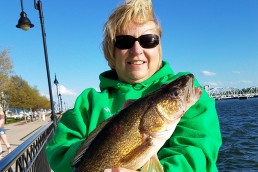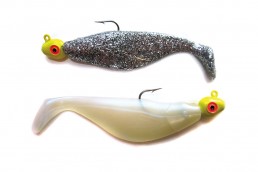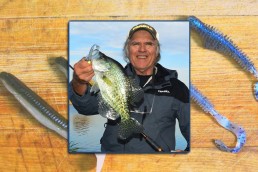The Soft Plastic Swimbait
SHARE THIS POST
I recently found myself in a position where I knew nothing about a particular fishing opportunity. I was 150 miles from home with no idea what the water temperatures were, no idea what species were available and a 20 miles-an-hour wind blowing in my face. Where do you start with that challenge in front of you?
What lure is the Swiss Army knife, the adjustable wrench, the “spork” of the shore casters arsenal? Without a doubt, it has to be the soft plastic swimbait!
There are a lot of baits out there that catch specific species very well. But the swimbait will catch everything. And by everything, I mean the cold-water species, trout and salmon, as well as pike, bass and walleyes. That covers pretty much everything you could encounter on a Wisconsin Lake Michigan pier or breakwall.
There are two styles of swimbaits. Both are good choices, but one is a little more versatile than the other.
The first is an integral weight swimbait, in which the weight is poured in the center of the plastic swim bait. One of the more readily available models of the integral weight type swimbaits is the Storm Wildeye Swim Shad. These baits are available in sizes from 2 to 6 inches long and are available in a variety of colors that mimic shad, alewives and emerald shiners perfectly. They are very realistic and well balanced.
The reason I would consider the integral weight less versatile is that they have a fixed weight. Although they come in a variety of sizes, there is an established weight inside of them. If that particular weight works for the situation, great. But if you need it heavier or lighter, it’s not an option with the integral weight swimbaits. One other factor is that if a tail gets bitten off, the lure is done. Don’t take these as negatives—these swimbaits are very realistic and catch fish—they’re just less versatile.
The other option in swimbaits is the jighead and swimbait tail combination. The jig becomes the head of the bait, the tail is the rest of the body. For this option, you can vary the weight of the head to fit the conditions, whether that’s a wind factor, depth or speed of retrieve. I like to carry a variety of heads from 3/16- to 1/2-ounce. The two workhorse weights are 1/4- and 3/8-ounce for most shore casting applications. You would think that those two weights are so close that it wouldn’t matter, but it does. In water less than 10 feet I generally use 1/4-ounce. In water deeper than that, I will go to 3/8. In wind, or if I want to speed up in shallower water, I may use the 3/8. Conversely, I may drop to 1/4 and light line if I wanted to fish slowly, and deep in winter. You get the idea. But that versatility is available in the head and tail combo.
Are you enjoying this post?
You can be among the first to get the latest info on where to go, what to use and how to use it!
Speaking of speed, different tails have different optimal speeds. Some tails swim very well at very slow speeds, but blow out if you want them to go fast. And some tails need a minimum speed to swim properly, which may be too fast for conditions. You have to test this for yourself. I pour most of my own swimbait tails, but before I did I used a lot of Big Hammer and Lunker City swimbait bodies. They are both very good bodies for our applications.
One thing I would like to warn you about are baits that are designed for saltwater fishing. The Great Lakes and saltwater baitfish are very similar, so I tried a lot of swimbaits that were designed for inshore species like speckled trout or snook or tarpon. They look great; but unfortunately, they are sometimes made with tougher plastic for saltwater fish durability. They are also fished at faster speeds and more aggressively for saltwater species. As good as these baits look, they don’t have much action at the speeds we generally fish them here on Lake Michigan. I have also noticed that when you get them in 30-something degree water, the plastic firms up and they don’t swim.
Scent is another possibility in swimbait tails. Berkley has both types of tails. The integral body is made in Power Bait options, and the Gulp is available in swimbait tails. The 3-inch Gulp Pogy is a good tail for jigheads if you feel more confident with scented baits.
As far as size to catch all species, a 3- or 3.5-inch is a very universal size all season long.
One thing I’d like to mention is wire leaders. I don’t like them, but I see a need for them if you are fishing swimbaits in areas with pike. Pike love swimbaits. This is up to you. I’ve been bit off so many times that I had to come to terms with myself, and start using wire in certain circumstances. In Green Bay, Sturgeon Bay, Door County, Milwaukee Harbor or Racine Harbor you just need to consider using them. The pike populations are very good in these regions, so it becomes necessary. So, the least invasive wire leaders are ones tied with coffee-colored single-strand wire in .011 or .012 diameters. Use a small (#10) but strong black swivel on one end, and either a small Duo-lock snap on the end, or tie the wire direct to the bait. Use the “haywire twist” to attach swivels or snaps. I have been using leaders when needed for a couple years now, and I have caught some very big browns when using them, so I don’t feel like I am spooking a sight-gifted trout when I have a leader on. Baits like big minnow baits are fairly safe from bite-offs, but Pike wolf down swimbaits.
As far as fishing swimbaits for any species, they’re a no brainer. Cast them out and let them sink to the bottom, or your desired depth, and start reeling. Throw in a few pauses and quick starts, but don’t over fish them. Swim them with the reel, don’t try to jig them. Less is more!
If you are ever faced with a situation where you don’t know what to use or what you may be able to catch, the swimbait is the Swiss Army knife of the shore fishing arsenal. It’s a great starter bait for all the warm-water and cold-water species we encounter along Wisconsin’s Lake Michigan shoreline.
MWO
SHARE THIS POST
Did you enjoy this post?
You can be among the first to get the latest info on where to go, what to use and how to use it!
Marc Wisniewski
Marc Wisniewski is an avid Wisconsin angler specializing in Lake Michigan shore and inshore fishing. He also chases bass, pike, and muskies anywhere he can. He has built custom rods for 35 years and makes lures from wood, lead and soft plastics. Wisniewski has been writing fishing articles for more than 30 years.



